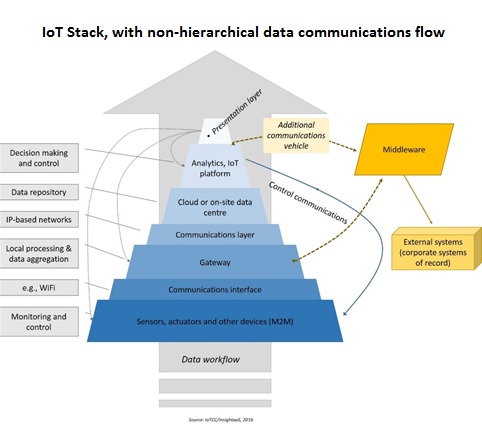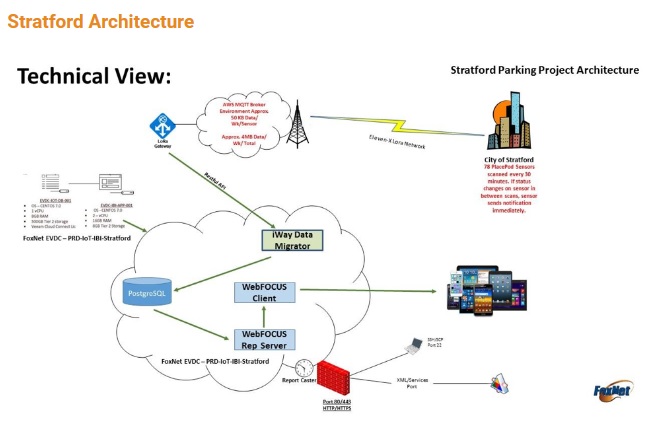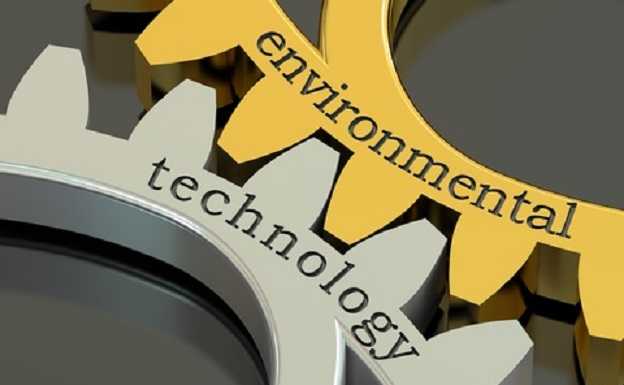IoT promises rich rewards to adopters and to the vendors who provision them – so long as everyone plays nicely in the sandbox. A mashup of new software, new sensor devices, multiple communications protocols and platforms, including M2M, and the ICT infrastructure needed to support the collection, analysis and storage of unprecedented volumes of data, IoT represents a notch up on the IT heterogeneity scale. In the diagram below, some sense of the complexity of IoT, and the need for intercommunication and reporting across various layers of the stack is shown.

This complex assembly of different technologies means that IoT is often described as an ‘ecosystem play’ – a solution area that depends on the interoperation of many data and communications systems, which currently are delivered by no single vendor. Due to IoT market immaturity, the need for provider relationships to support the seamless delivery of IoT-based insights has been more ad hoc than habitual, and unique architectural models designed to support individual use cases more typical than the deployment of standard approaches. But that outlook is changing – as users build familiarity and experience with solution potential, and as providers begin to establish the partnerships needed to build end-to-end IoT products and services.

At a recent breakfast presentation with Information Builders (IB), a New York based data and analytics firm with growing presence in Canada, shifts that are underway in the local market were on display – in the evolution of Canadian IoT relationships and in the demonstration of home-grown innovation. But in his introductory remarks, Information Builders CMO Michael Corcoran launched the session with an observation that speaks to the complexity in IoT: while many IB technologies, such as visualization and predictive analytics may be part of the IoT stack, many competitors in the dashboard and analytics market are not equipped to support operational analytics or the real time access to data which is needed in the case of IoT. He next defined an IoT Solutions Architecture consisting of four stages: sensors and actuators; gateways and other data acquisition technologies; analytics processing at the network edge; and data centre/cloud processes. IB plays at each stage, he added, via analytics management control software that identifies what data needs to be collected, how frequently it needs to be connected, and when it should be pushed across the Internet. And IB’s ability to reach into the presentation, analytics, cloud and edge layers of the IoT stack to support data management, analysis and integration is what sets the company apart from more limited providers of visualization solutions.
According to Corcoran, the combination of IoT data and analytics has translated into the emergence of “smart initiatives” that are bundled under the umbrella terms Smart Factory, Smart Warehouse and Supply Chain, Smart Fleet, Smart Store & Mall, Smart Hospital, Smart Grid, and Smart City. IB is now working with customers across many of these vertical solution areas, leveraging data integrity, business intelligence and data integration tools to locate new sources of value. Corcoran believes that much of the value in these kinds of initiatives is created through the connection of IoT and other data sources, and he cited the Boeing example, which, with IB’s help, collects data on GE turbines (when planes land), linking this to other data sets for predictive maintenance analysis so that Boeing now sells hours of plane engine time, rather than the engine itself. Similarly, IB is deploying a data management system on Navistar trucks which will alert the company to upcoming maintenance challenges. It is working with the autonomous vehicle team at GM Engineering on testing and with creators of GM’s OnStar system to deliver GIS information that will point the driver towards the closest service centre should a part begin to fail. It is also working with auto parts delivery company AutoZone, to monitor the performance of its fleet of delivery vehicles to ensure that they are delivering parts to waiting repair shops as quickly as possible. With Lipari Foods, IB has enabled analysis of data collected from delivery trucks and in the company’s warehouse to better manage food quality, safety and delivery  efficiency: Lipari monitors truck speed, temperature, arrival time, idle time, seatbelt click, off track time, and in the warehouse, it has IoT tags in place to trace the correct product number, inventory, case size and weight, the required lift height, pallet weight, and aisle, as well as movement within the space, damage prone areas, cross contamination, and top selling inventory. The goal is to optimize food logistics along the entire supply chain, and to reduce warehouse space by a factor of five. As Corcoran noted, “People getting creative – connecting data in a creative way and the results are phenomenal….” In recent research from MPI, he added,
efficiency: Lipari monitors truck speed, temperature, arrival time, idle time, seatbelt click, off track time, and in the warehouse, it has IoT tags in place to trace the correct product number, inventory, case size and weight, the required lift height, pallet weight, and aisle, as well as movement within the space, damage prone areas, cross contamination, and top selling inventory. The goal is to optimize food logistics along the entire supply chain, and to reduce warehouse space by a factor of five. As Corcoran noted, “People getting creative – connecting data in a creative way and the results are phenomenal….” In recent research from MPI, he added,
“each project has shown positive, clear ROI through increased efficiency, cost control and revenue return.”
Beyond the transport industry, IB has also worked on projects with municipalities, such as Richmond BC, which provided an early example of the city’s use of IoT to monitor drainage and sewage systems to detect rising water levels – to predict future risk and alert the population on possibility of flooding. In Mexico City, IB was involved in an initiative to manage smog through a system that tracks vehicles and their emissions ratings; cars are tagged, and if drivers don’t have the proper accreditation, they will be subject to fines.
But at the event, IB also invited local partners to describe how they are helping to deliver IoT innovation. For example, Bill Dupley, digital strategist for FoxNet Solutions, outlined the development of an IoT parking pilot for the City of Stratford, ON, which focused first on the development of a business case that would drive deployment. In Stratford’s case, the goal was to improve parking ease for theatre goers and patrons of local businesses, while opening up data to entrepreneurs via Canada’s Open Data Exchange (ODX) to push local innovation. Dupley also provided a fascinating glimpse into some of the architectural considerations involved in the project: implementers of a smart parking solution would need to understand what data needs to be collected, taking a functional view of data flow from “People to Things, People to Machines, Machines to Machines” to identify the minimal amount of data that can be collected to support the business case for deployment. From a technical perspective, the project involved questions around solutions architecture in four areas: how would the data be collected from the sensors; how would it be aggregated; can data be pre-processed at the edge; and how/where will analytics and reporting take place (via on-premise data centre, cloud or SaaS services). As shown in the figure below from FoxNet, the architecture for the Stratford parking project relies on PNI PlacePod sensors which sense whether a parking spot is occupied, data is collected using the Eleven-x LoRa network, and an AWS MQTT broker (ISO standard messaging protocol) aggregates the data and pushes it through the LoRa (low power, wireless) gateway. At the gateway, it is retrieved by the IB Data Migrator product using restful API access, which translates the API messages to a data repository. Data from a PostgreSQL database is then sent to an IB WebFOCUS server for analysis, and a WebFOCUS client is used to reduce the reports. The IB software stack resides on the FoxNet public cloud service.

Stratford’s smart parking pilot provides a compelling example of the interplay of various technologies in the creation of IoT business value. Hosted in the FoxNet cloud, the solution relies on PlacePod sensing hardware, Eleven-x networking, and IB data management, analytics and reporting capabilities to support the municipality’s business goals, while generating data for open exchange to support innovation in the broader, entrepreneurial community. An ‘ecosystem play’…..








